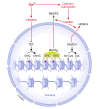Calcium regulation of stem cells
- PMID: 32419314
- PMCID: PMC7271657
- DOI: 10.15252/embr.202050028
Calcium regulation of stem cells
Abstract
Pluripotent and post-natal, tissue-specific stem cells share functional features such as the capacity to differentiate into multiple lineages and to self-renew, and are endowed with specific cell maintenance mechanism as well as transcriptional and epigenetic signatures that determine stem cell identity and distinguish them from their progeny. Calcium is a highly versatile and ubiquitous second messenger that regulates a wide variety of cellular functions. Specific roles of calcium in stem cell niches and stem cell maintenance mechanisms are only beginning to be explored, however. In this review, I discuss stem cell-specific regulation and roles of calcium, focusing on its potential involvement in the intertwined metabolic and epigenetic regulation of stem cells.
Keywords: calcium; epigenetics; metabolism; pluripotent stem cells; post-natal stem cells.
© 2020 The Author.
Conflict of interest statement
The authors declare that they have no conflict of interest.
Figures





Similar articles
-
Epigenetic regulation of stem cell differentiation.Pediatr Res. 2006 Apr;59(4 Pt 2):21R-5R. doi: 10.1203/01.pdr.0000203565.76028.2a. Pediatr Res. 2006. PMID: 16549544 Review.
-
[The alchemy--epigenetic regulation of pluripotency].Postepy Biochem. 2013;59(2):144-56. Postepy Biochem. 2013. PMID: 24044279 Review. Polish.
-
Epigenetic Regulation of Transition Among Different Pluripotent States: Concise Review.Stem Cells. 2019 Nov;37(11):1372-1380. doi: 10.1002/stem.3064. Epub 2019 Aug 14. Stem Cells. 2019. PMID: 31339608 Review.
-
Epigenetics, stem cells and epithelial cell fate.Differentiation. 2009 Sep-Oct;78(2-3):99-107. doi: 10.1016/j.diff.2009.07.002. Epub 2009 Jul 24. Differentiation. 2009. PMID: 19632029 Review.
-
Shushing down the epigenetic landscape towards stem cell differentiation.Development. 2010 Aug 1;137(15):2455-60. doi: 10.1242/dev.049130. Epub 2010 Jun 16. Development. 2010. PMID: 20554719
Cited by
-
Calcium Signaling Regulates Autophagy and Apoptosis.Cells. 2021 Aug 18;10(8):2125. doi: 10.3390/cells10082125. Cells. 2021. PMID: 34440894 Free PMC article. Review.
-
PIEZO1-mediated calcium signaling reinforces mechanical properties of hair follicle stem cells to promote quiescence.Sci Adv. 2025 May 30;11(22):eadt2771. doi: 10.1126/sciadv.adt2771. Epub 2025 May 28. Sci Adv. 2025. PMID: 40435254 Free PMC article.
-
Calling long distance: Cell cycle-dependent Ca2+ flows connect stem cells across regeneration tissues.J Cell Biol. 2023 Jul 3;222(7):e202305022. doi: 10.1083/jcb.202305022. Epub 2023 Jun 14. J Cell Biol. 2023. PMID: 37314732 Free PMC article.
-
Engineering biomimetic bone marrow niche with gene modified mesenchymal stromal cells for ex vivo culture of human hematopoietic stem and progenitor cells.Stem Cell Res Ther. 2025 Jul 1;16(1):335. doi: 10.1186/s13287-025-04474-4. Stem Cell Res Ther. 2025. PMID: 40598600 Free PMC article.
-
Role of vitamin D and calcium signaling in epidermal wound healing.J Endocrinol Invest. 2023 Feb;46(2):205-212. doi: 10.1007/s40618-022-01893-5. Epub 2022 Aug 13. J Endocrinol Invest. 2023. PMID: 35963983 Free PMC article. Review.
References
-
- Takahashi K, Yamanaka S (2006) Induction of pluripotent stem cells from mouse embryonic and adult fibroblast cultures by defined factors. Cell 126: 663–676 - PubMed
-
- Yamanaka S (2009) A fresh look at iPS cells. Cell 137: 13–17 - PubMed
-
- Park IH, Zhao R, West JA, Yabuuchi A, Huo H, Ince TA, Lerou PH, Lensch MW, Daley GQ (2008) Reprogramming of human somatic cells to pluripotency with defined factors. Nature 451: 141–146 - PubMed
Publication types
MeSH terms
Substances
Grants and funding
LinkOut - more resources
Full Text Sources

